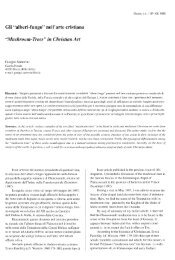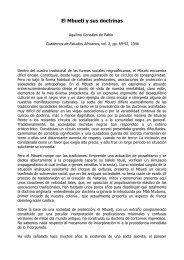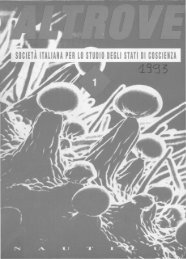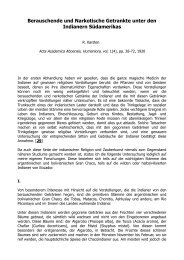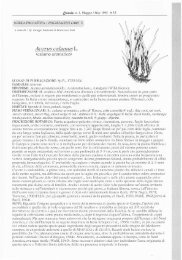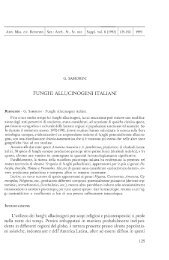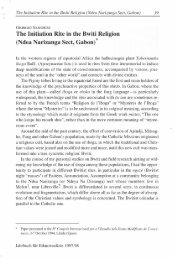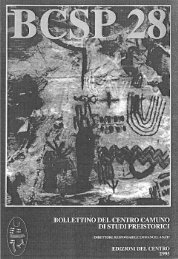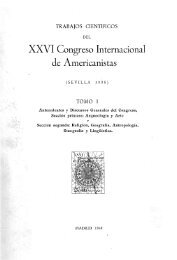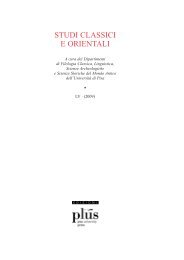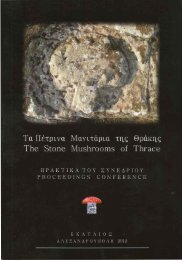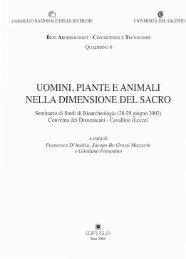Religious or Sacred Plants of Basutoland
Religious or Sacred Plants of Basutoland
Religious or Sacred Plants of Basutoland
You also want an ePaper? Increase the reach of your titles
YUMPU automatically turns print PDFs into web optimized ePapers that Google loves.
<strong>Religious</strong> <strong>or</strong> <strong>Sacred</strong> <strong>Plants</strong> <strong>of</strong> <strong>Basutoland</strong><br />
Rev. F. Laydevant<br />
Bantu Studies, vol. 6, pp. 65-69, 1932<br />
[65] The hist<strong>or</strong>y <strong>of</strong> the various religions is connected with many other sciences. In <strong>or</strong>der<br />
to have a th<strong>or</strong>ough knowledge <strong>of</strong> the religious ideas <strong>of</strong> a nation, it is <strong>of</strong>ten necessary to<br />
consult the geography, the hist<strong>or</strong>y, the ethnology and even the botany <strong>of</strong> that nation's<br />
country. It is indeed surprising to note how plants have played a considerable part in the<br />
religious and magical customs <strong>of</strong> primitive people.<br />
The ancient Slavonic people w<strong>or</strong>shipped the oak tree because the lightning used to strike<br />
it with remarkable frequency. The Gauls and their Druids w<strong>or</strong>shipped the mistletoe on<br />
account <strong>of</strong> wonderful properties it was said to possess.<br />
Acc<strong>or</strong>ding to a French auth<strong>or</strong>, Michaud, the hist<strong>or</strong>ian <strong>of</strong> the Crusades, a Persian sect <strong>or</strong><br />
tribe, the Hashishim by name, venerated the hashish <strong>or</strong> Indian hemp (cannabis sativa),<br />
which they used to excite their religious fanaticism when they were commanded to destroy<br />
some enemy. It is from the name hashishim that we derive the English w<strong>or</strong>d assassinate.<br />
The vine, whose produce has the quality <strong>of</strong> rejoicing the hearts <strong>of</strong> men, was sacred to the<br />
Greeks and the Romans, who set over it the gods Dyonisius and Bacchus as its protect<strong>or</strong>s.<br />
Acc<strong>or</strong>ding to an article which appeared last June in a European review, there are now in<br />
Siberia some tribes which venerate a kind <strong>of</strong> mushroom, (the amanita phalloides), a<br />
fungus also found in South Africa and famous f<strong>or</strong> producing a drunken state accompanied<br />
by fantastic dreamings. The same article also mentions that in Mexico some Indian tribes<br />
w<strong>or</strong>ship a small cactus called echinocactus williamsii, which is used in the same way as the<br />
above-mentioned fungus.<br />
The Basuto <strong>of</strong> South Africa, apart from smoking the hemp, <strong>or</strong> dagga, as it is commonly<br />
called, (the smoking <strong>of</strong> which has no connection with any religious ceremony), also make<br />
use <strong>of</strong> certain plants f<strong>or</strong> producing a state <strong>of</strong> intoxication during heathen ceremonies.<br />
At the commencement <strong>of</strong> the initiation period, Basuto boys are given a mess <strong>of</strong> p<strong>or</strong>ridge<br />
which makes them drunk. It acts like a strong dose <strong>of</strong> alcohol on some natures, while on<br />
others it has a sickening <strong>or</strong> stupefying effect. F<strong>or</strong> a long time the writer <strong>of</strong> this article has<br />
suspected that the plant used f<strong>or</strong> this purpose was the plant called buphane toxicaria, but<br />
<strong>of</strong> this he was not certain, because the Native witch-doct<strong>or</strong>s exercise [66] great care in<br />
not divulging their secrets, especially to White people. It was only recently, by the use <strong>of</strong><br />
diplomacy and the help <strong>of</strong> a financial grant given by the Bantu Research Committee <strong>of</strong> the<br />
University <strong>of</strong> the Witwatersrand, that the writer was able to ascertain the real name <strong>of</strong> this
secret medicine.<br />
The buphane, called leshoma by the Basuto, is usually found on the hill slopes, and<br />
prefers the sunny n<strong>or</strong>thern side to a spot less congenial and warm. It has a large bulb<br />
growing partly above the ground and partly below, weighing from eight to twelve pounds.<br />
Towards the middle <strong>of</strong> October every year, it shoots f<strong>or</strong>th a bundle <strong>of</strong> leaves which grow<br />
and spread out fanwise. At the same time a stalk also grows, which bears at its apex an<br />
umbel <strong>of</strong> pinkish flowers having some similarity to those <strong>of</strong> the nerine, but <strong>of</strong> a colour less<br />
bright than that bloom. In honour <strong>of</strong> the buphane the Basuto have named the month <strong>of</strong><br />
October mphalane ea leshoma, "the stalk <strong>of</strong> the buphane".<br />
Acc<strong>or</strong>ding to the writer's inf<strong>or</strong>mants (two Native witch-doct<strong>or</strong>s who gave their inf<strong>or</strong>mation<br />
separately) the bulb is very poisonous, and when mixed with the food <strong>of</strong> the initiates at<br />
the circumcision lodge, it must first be carefully measured. The taste is not bitter, and the<br />
boys do not object to its flavour. In this instance, the buphane is not used alone, but<br />
mixed with several ingredients <strong>of</strong> other plants and remedies, including the preserved flesh<br />
<strong>of</strong> enemies killed in war.<br />
The initiates are taught that such a remedy will imbue them with the qualities <strong>of</strong> their<br />
ancest<strong>or</strong>s and will tend to make men <strong>of</strong> them. When the signs <strong>of</strong> intoxication produced by<br />
the mixture are apparent, they are accepted as a token that the spirit <strong>of</strong> manhood has<br />
entered the youth's body1.<br />
This custom is not peculiar to the Basuto nation only. It appears that in many tribes the<br />
use <strong>of</strong> a similar remedy is an essential part in the initiation rites. Mgr. Leroy, in his book<br />
The Religion <strong>of</strong> the Primitives, says that the people <strong>of</strong> Sette Cama, in Central Africa, give<br />
to the initiates a decoction from the bark <strong>of</strong> a tree known to the botanists under the name<br />
<strong>of</strong> Strychnos Ikaja, and that the person who takes this mixture, <strong>or</strong> remedy, becomes<br />
unconscious f<strong>or</strong> a stretch <strong>of</strong> about three days. A peculiar property <strong>of</strong> the buphane is that<br />
under special circumstances it is not poisonous.<br />
[67] The Basuto herdboys sometimes take two <strong>or</strong> three <strong>of</strong> its outer leaves and use them<br />
as a cup <strong>or</strong> receptacle f<strong>or</strong> milking goats. When the cup <strong>or</strong> receptacle is ready and filled<br />
with milk, it is put over a fire, and the milk, without boiling, very soon thickens; this is<br />
probably through an emanation from the leaves, which themselves do not burn, their<br />
c<strong>or</strong>ners only becoming slightly charred. The herdboys relish this f<strong>or</strong>m <strong>of</strong> thick-milk and it<br />
produces no ill effect on them.<br />
F<strong>or</strong> the initiation <strong>of</strong> the witch-doct<strong>or</strong>s and its accompanying ceremonies, another species<br />
<strong>of</strong> native plant is used. The concoction made there from is said to be non-poisonous,<br />
though Natives attribute to it great powers <strong>of</strong> acting on the brain and developing the<br />
mental faculties, especially the mem<strong>or</strong>y. This plant is a species <strong>of</strong> South African f<strong>or</strong>get-menot<br />
<strong>or</strong> myosotis having white flowers. The Basuto call it sethuthu and the Matebele <strong>or</strong><br />
Zulus call it lephukhuphukhu.<br />
It is supposed to aid the medicine man in remembering with ease the names and<br />
properties <strong>of</strong> the various plants, and also the facts and circumstances which will help him<br />
to carry on his w<strong>or</strong>k in a successful manner. It is a known fact that many <strong>of</strong> these doct<strong>or</strong>s<br />
are really clever fellows and possess keen intellects, but whether they owe their cleverness<br />
to the use <strong>of</strong> this plant <strong>or</strong> not, is another question. The same plant is also used f<strong>or</strong> sick
persons undergoing a partial <strong>or</strong> temp<strong>or</strong>ary initiation.<br />
Among the Natives <strong>of</strong> South Africa there are many cases <strong>of</strong> hysteria, and the complainants<br />
suffering from this mysterious disease speak <strong>of</strong> various sicknesses which exist only in their<br />
imagination. F<strong>or</strong> such illnesses European doct<strong>or</strong>s usually prescribe a general and mental<br />
treatment. Now, when such a case is brought to the notice <strong>of</strong> the witch-doct<strong>or</strong>, he throws<br />
down his lotaola <strong>or</strong> divining-bones and chants: Motho eo o na le moea, "This person has<br />
the spirit." By special permission from his <strong>or</strong> her relatives, the person ailing goes f<strong>or</strong> a<br />
period to live at the home <strong>or</strong> near the home <strong>of</strong> the witch-doct<strong>or</strong> in <strong>or</strong>der to be under his<br />
personal supervision.<br />
A special medicine is then prepared f<strong>or</strong> him, <strong>of</strong> which the main ingredient is the sethuthu,<br />
while the other plants are usually the m<strong>or</strong>ara o moholo, a kind <strong>of</strong> polygonum, the plant<br />
bolao ba maqekha, the charm <strong>of</strong> the witch-doct<strong>or</strong>s, a kind <strong>of</strong> polygala, and the plant<br />
seharane, <strong>or</strong> galium witbergense. Some witch-doct<strong>or</strong>s mix the sethuthu with the plant leta<br />
la ph<strong>of</strong>u, the eland's saliva <strong>or</strong> agapanthus umbellatus. The roots <strong>of</strong> these plants are<br />
cooked together, and when the decoction is stirred, it produces a great amount <strong>of</strong> foam,<br />
which is caused mainly by the sethuthu.<br />
[68] When the patient has taken this foam <strong>or</strong> medicine, he is supposed to think and<br />
dream <strong>of</strong> other plants and remedies, which he collects early the following m<strong>or</strong>ning. After<br />
one <strong>or</strong> two months he is considered cured. His <strong>or</strong> her relatives then get ready f<strong>or</strong> a feast<br />
and a great deal <strong>of</strong> beer is prepared. They also sacrifice an ox, <strong>of</strong> which the patient has<br />
also dreamed and which has been designated by him. On an appointed day a dance is<br />
held, the witch-doct<strong>or</strong>s <strong>of</strong> the neighbourhood taking part in full dress, and <strong>of</strong>ten<br />
proceeding to jump and dance till complete exhaustion sets in. After the feast a head <strong>of</strong><br />
cattle is presented to the witch-doct<strong>or</strong> as a fee, and the person f<strong>or</strong>merly under his care<br />
returns to his home to attend to his duties once m<strong>or</strong>e. Many persons seem to be cured by<br />
this treatment when other remedies have failed.<br />
Can it be possible that in these plants rests an ingredient which has beneficial effects on<br />
the brain and on the nervous system? It is the w<strong>or</strong>k <strong>of</strong> the doct<strong>or</strong>s, and m<strong>or</strong>e especially <strong>of</strong><br />
the analyst, to elucidate the question. Let us only note that, acc<strong>or</strong>ding to Pr<strong>of</strong>s. Watt and<br />
Brandwijk ("Bantu Studies" <strong>of</strong> July 1927) a plant closely allied to the sethuthu, the<br />
cynoglossum <strong>of</strong>ficinale, "contains an alkaloid with a curare-like action." We must also note<br />
that the sethuthu is the main ingredient <strong>of</strong> a charm, a kind <strong>of</strong> balm used by the Basuto f<strong>or</strong><br />
anointing the body <strong>of</strong> a young bride after the marriage ceremony and bef<strong>or</strong>e she goes to<br />
her husband.<br />
Another imp<strong>or</strong>tant remedy, <strong>or</strong> charm, used by the Basuto during their religious<br />
ceremonies, is the medicine kept in cast-<strong>of</strong>f cattle h<strong>or</strong>ns, a composition <strong>of</strong> roots, parts <strong>of</strong><br />
birds and other animals, and sometimes the flesh <strong>of</strong> slain enemies, the whole concoction<br />
being first charred and mixed with fat.<br />
The composition <strong>of</strong> these manaka (h<strong>or</strong>ns) is not always the same. It varies acc<strong>or</strong>ding to<br />
the different purposes f<strong>or</strong> which it is used. During the rites <strong>of</strong> initiation, a special kind <strong>of</strong><br />
h<strong>or</strong>n-medicine is used in connection with the intoxicating food already mentioned. It is<br />
then called sehoere by the Basuto. Acc<strong>or</strong>ding to one inf<strong>or</strong>mant the sehoere is made from<br />
the following ingredients: Mothokho, <strong>or</strong> ipomoea oblongata, Mothoto, <strong>or</strong> cyperus<br />
fastigiatus, qoboi <strong>or</strong> the root <strong>of</strong> the phragmites communis, m<strong>or</strong>ara o moholo, a kind <strong>of</strong>
polygonum, setima mollo, <strong>or</strong> pentanisia variabilis, leshokhoa <strong>or</strong> xysmalobium undulatum,<br />
mafifi matso <strong>or</strong> phygelius capensis, motsitla <strong>or</strong> the rush typha latifolia, human flesh, and<br />
the flesh <strong>of</strong> the secretary bird, (the leshokhoa). One <strong>of</strong> these plants is slightly toxic, and<br />
sometimes the Basuto women take advantage <strong>of</strong> this property f<strong>or</strong> making their beer m<strong>or</strong>e<br />
intoxicating. The beer is then called joala ba hiki.<br />
[69]It would be incomplete to write about the sacred plants <strong>of</strong> <strong>Basutoland</strong> without<br />
mentioning a very common one used in the course <strong>of</strong> everyday life and also in the<br />
religious ceremonies. This plant is the kaffir c<strong>or</strong>n, used by the Natives f<strong>or</strong> making bread<br />
and p<strong>or</strong>ridge, and also their beer, joala, which is the cause <strong>of</strong> much drunkenness along<br />
them. When the Basuto thresh their kaffir c<strong>or</strong>n, <strong>or</strong> s<strong>or</strong>ghum, they dig a hole in the ground,<br />
right in the centre <strong>of</strong> the thr shing flo<strong>or</strong>. All the grain which falls into this central hollow is<br />
made into a beer called joala ha leoa, meaning "the beer <strong>of</strong> the fall." This beer is <strong>of</strong>fered<br />
to the spirits <strong>of</strong> the Basuto ancest<strong>or</strong>s, and a few drops are sprinkled into the fireplace in<br />
their honour. At the burial ceremonies, the Basutos used f<strong>or</strong>merly to throw into the grave<br />
some grains <strong>of</strong> kaffir c<strong>or</strong>n, to he sown, as they believed, by the departed spirit in the land<br />
in which it will live.<br />
This useful plant is not without special merit, and theref<strong>or</strong>e praises are sung in its honour.<br />
Here are the praises, <strong>or</strong> lithoko, <strong>of</strong> the kaffir c<strong>or</strong>n:<br />
Ngoetsi ea malapa ohle,<br />
Khunoana ralithlaku thabisa lihoho,<br />
Thabisa ha hlolang ba koatile.<br />
The daughter in law <strong>of</strong> every house,<br />
The brown one which with its many grains rejoices the hearts,<br />
Rejoices even those who are always sulky.<br />
Notes<br />
1) This remedy is also considered as a cup <strong>or</strong> draught <strong>of</strong> inspiration f<strong>or</strong> the initiates at the<br />
circumcision lodge. During the initiation period, every boy has to compose a piece <strong>of</strong><br />
poetry <strong>or</strong> praises, which he will recite publicly when he is liberated and the medicine which<br />
is given to them is supposed to communicate the gifts <strong>of</strong> poetry and eloquence.



